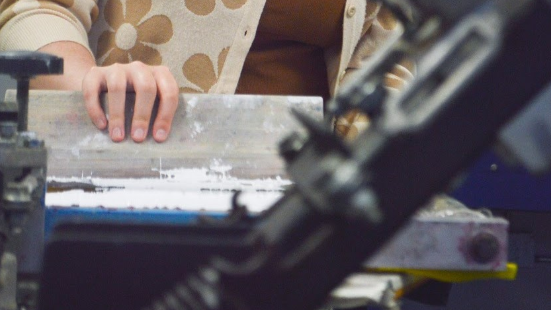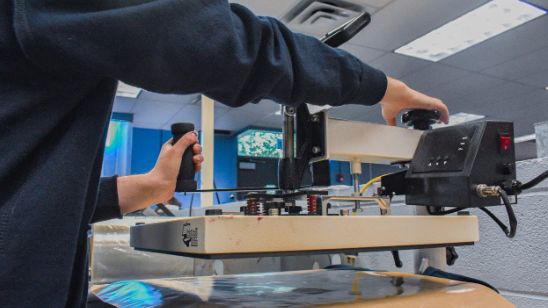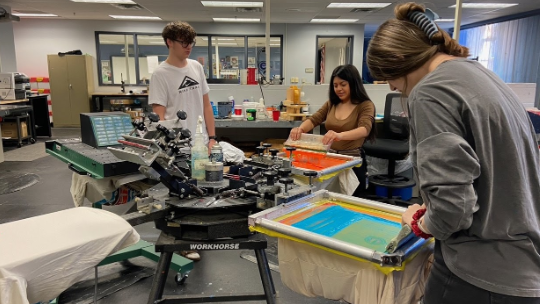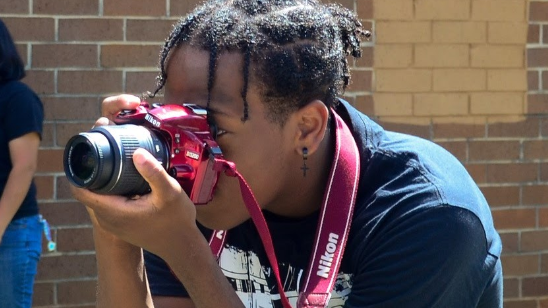Graphic Communications
(Honors Level Course)
Mrs. Cheryl Bennefield
Graphic Communications is a dynamic field that blends art, design, technology, and business. Professionals in this industry use computer software to design, create, and prepare artwork for both print and digital media. The work stretches across many platforms—from commercial printing and publishing to web design, animation, video, and creative design. With one of the largest global footprints of any industry, graphic communications plays a key role in connecting people through creative visuals and effective communication.
Our Graphic Communications program is part of the South Carolina Arts, Entertainment, and Design Career Cluster. This honors-level program provides students with advanced training in design and production while preparing them for college and career opportunities in the creative industries.
What you’ll do:
- Learn computer software for graphic design, layout, and digital imaging
- Develop skills in commercial printing and publishing
- Explore creative design for web, video, and animation
- Apply design principles to real-world projects and client-style work
Certifications you can earn:
- Tier 1: OSHA-10
- Tier 2: Adobe Certified Professional (various applications)
- Tier 3: Advanced Adobe or industry certifications
Students earn two high school credits each semester and up to eight credits over the two-year program. Credits count as electives toward South Carolina graduation requirements, and one credit may fulfill the CATE/Foreign Language requirement.
Visit us: Are you interested in meeting Mrs. Bennefield and touring our Graphic Communications lab? After-school tours for prospective students and parents are available in December, January, and February. We’d love to show you the program and answer any questions you may have.
Year One: Building the Foundation

Graphic Communications 1 & 2 — (AM Session at Enoree)
Year one of the Graphic Communications program introduces students to the foundations of design and production in an honors-level course that blends creativity with technical skill. Open to rising 10th and 11th graders, students attend Enoree Career Center during the morning session as part of their two-year commitment. Training focuses on the safe and effective use of industry-standard software and equipment while emphasizing the principles of design, layout, and digital imaging. Students gain hands-on experience working with Adobe Creative Cloud applications, learning how to create and prepare artwork for both print and digital platforms.

As students progress through Graphic Communications 2, they expand into more advanced applications of design, including typography, color theory, and preparing files for commercial printing and digital media. Instruction balances classroom learning with project-based work, giving students opportunities to develop professional-quality designs and practice problem-solving in creative contexts.
By the end of year one, students will have completed multiple projects that demonstrate their growing skills in art, design, and technology. They leave the first year with a portfolio of work, experience using industry-standard tools, and the confidence to take on more advanced projects and certification opportunities in year two.
Year Two: Advancing the Skills
Graphic Communications 3 & 4 — (PM Session at Enoree)
Year two of the Graphic Communications program builds on the foundation of year one and challenges students to apply their creative and technical skills to advanced design and production projects. Students attend Enoree Career Center during the afternoon session as part of their two-year commitment. Training expands into more complex design principles, digital publishing, branding, and advanced production techniques, while also emphasizing accuracy, creativity, and problem-solving. This combination prepares students for both college-level coursework and entry into the creative workforce with the technical ability and professional portfolio expected by today’s design industry.

As students progress through Graphic Communications 3 and 4, they take on real-world style assignments that integrate multiple design tools and production processes. Students learn advanced Adobe Creative Cloud applications, practice preparing files for commercial printing and digital platforms, and explore projects in web design, branding, and digital media. Instruction emphasizes accuracy, creativity, and problem-solving while maintaining professional standards for client-ready work.
By the end of year two, students will be prepared to test for Adobe Certified Professional credentials in applications such as Photoshop, Illustrator, or InDesign. They will graduate with a portfolio of professional-quality work, recognized certifications, and the skills needed to transition confidently into technical college programs, apprenticeships, or immediate employment in the graphic communications field.

Career Opportunities


Press Operator
A press operator or printer oversees job setup, operation, and production. They must maintain a close eye on image registration and quality control throughout the print job. Operators are also responsible for basic equipment repairs as well as daily maintenance. They will install and load image carriers/plates, substrate, and ink while ensuring that the printed pieces are produced to optimum quality.
Salary - $40,520 per year on average, or $19.48 per hour
Photographer
Photography has a very wide spectrum of specialties and responsibilities ranging from an artificially lit studio shoots to traveling for on-location sessions or occasions. They must have an eye for looking at an everyday objects or situations and capturing them to make them exceptional. Photographers use their technical expertise, creativity and composition skills to produce memorable images made to capture a story or record an event.
Salary- $41,070 per year on average, or $19.75 per hour
Graphic Designer
Graphic designers create visual concepts using digital images and computer software to communicate ideas that inspire, inform, and captivate consumers. They are trained to develop overall layouts and production designs for various applications such as advertisements, brand identity, brochures, magazines, and corporate reports.
Salary - $49,450 per year on average, or $23.77 per hour
Job Skills & Requirements
Each skill and trade requires a specific skill set to master the content and job tasks. Below are a few critical skills and requirements needed to succeed in the program and throughout a career in this field.
- Creativity: Creativity is essential in any design or photography field as they require out-of-the-box thinking and unique perspectives. Whether creating logos, posters, advertisements, or print media, all must appeal to their target audience. Designers and Photographers must be able to imagine what the design or photo will look like as an idea or concept before it has run through to completion. This allows them to easily translate their ideas into reality using a team or the tools at their disposal.
- Communication: Communication skills are important in graphic design as it allows designers to explain a message or concept visually to the public or their team while designing artwork with a team to aid in their direction for the job.
- Attention to detail: Attention to detail is important for designers as their roles often involve knowing the technical specifications of a design in a way that allows them to produce artwork with precision and accuracy. For example, they might design a circle with exact dimensions to place on the header of a website page. Having attention to detail also allows them to notice small errors or design flaws within their work and others. A photographer’s attention to detail is more immediate and in the moment. They must notice small items, such as a person's eye looking away from the camera in a group photo. It is a detail that can be easily corrected but just as easily ruin an image.
- Technology: Knowledge of your equipment or technology, such as software programs, is also essential in a creative field. Without understanding your camera, press, computer, or editing software, you will never be able to achieve the outcome of a job to its full potential. This includes printing, image capture and editing, design layout, and production.
- Time management: Time management is important because you must operate on project deadlines in any creative field. Any information, images, or approval delay can cost the company and the customer money. For example, they may manage a team to ensure that each member knows what expectations exist for them. If they don’t meet that expectation, it delays the following teammate.
Available Certification Opportunities
(Click logos below for more information)
Local Work-Based Learning Partners
(Click logos below to visit our partners)
NOTE: Credits earned will count as electives needed for the SC high school graduation requirements. One of the credits earned may fulfill the CATE/Foreign Language requirement for SC high school graduation. Most 4-year colleges will NOT accept career center courses as a substitute for the foreign language college admissions requirement.







